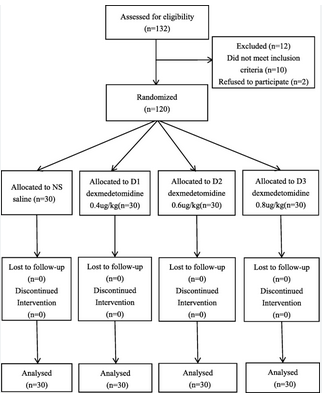A Comparative Study to See the Effects of Perioperative Infusion of Lidocaine vs Dexmedetomidine on Hemodynamic Parameters in Patients Undergoing Laparoscopic Cholecystectomy Surgery
Main Article Content
Abstract
Background: Laparoscopic cholecystectomy is also found to be attributing to stress response and significant alteration of hemodynamics due to effects of pneumoperitoneum, patient’s position, and hypercapnia by absorption of CO2 as a result of pneumoperitoneum. It is also important to have good postoperative pain control for early recovery after laparoscopic cholecystectomy (LC). Intravenous lidocaine has anti-hyperalgesic, anti-inflammatory and analgesic effects while dexmedetomidine provides anti-nociception, analgesic, sedative and sympatholytic effects. Both these drugs can be used as adjuvants to improve recovery after LC.
Aim and Objective: To see the effects of perioperative infusion of Lidocaine vs dexmedetomidine on hemodynamic parameters during perioperative period in patients undergoing laparoscopic cholecystectomy surgery.
Methodology: The study, a non-randomized controlled trial conducted in a hospital setting, took place from 2019 to 2020 in the department of anesthesia at Santosh Medical College and Hospital in Ghaziabad, India. In this study, patients of either gender between the ages of 18yrs and 60yrs were scheduled for laparoscopic cholecystectomy. To perform a laparoscopic cholecystectomy, 70 adult patients of either sex who had ASA grades I or II were admitted. They were randomly split into two groups of 35 patients each.
Article Details
References
Barkun JS, Wexler MJ, Hinchey EJ, Thibeault D, Meakins JL. Laparoscopic versus open inguinal herniorrhaphy: preliminary results of a randomized controlled trial. Surgery. 1995; 118:703 10.
Buanes T, MjÂland O. Complications in laparoscopic and open cholecystectomy: a prospective comparative trial. Surg Laparoscopy Endosc. 1996; 6:266 72.
Mendoza-Sagaon M, Hanly E, Talamini M, Kutka M, Gitzelmann C, Herreman-Suquet K, et al. Comparison of the stress response after laparoscopic and open cholecystectomy. SurgEndosc. 2000; 14:1136 41.
Jatzko GR, Lisborg PH, Pertl AM, Stettner HM. Multivariate comparison of complications after laparoscopic cholecystectomy and open cholecystectomy. Ann Surg. 1995; 221:381.
Boddy AP, Mehta S, Rhodes M. The effect of intraperitoneal local anesthesia in laparoscopic cholecystectomy: a systematic review and meta-analysis. Anesth Analg. 2006; 103:682 8.
Bisgaard T, Kehlet H, Rosenberg J. Pain and convalescence after laparoscopic cholecystectomy. Eur J Surg. 2001;167(2):84 96.
Bisgaard T, Klarskov B, Rosenberg J, Kehlet H. Factors determining convalescence after uncomplicated laparoscopic cholecystectomy. Arch Surg. 2001; 136:917 21.
Morsy KM, Abdalla EEM. Postoperative pain relief after laparoscopic cholecystectomy: intraperitoneal lidocaine versus nalbuphine. Ain-Shams J Anaesthesiol. 2014; 7:40.
Alkhamesi N, Peck D, Lomax D, Darzi A. Intraperitoneal aerosolization of bupivacaine reduces postoperative pain in laparoscopic surgery: a randomized prospective controlled double-blinded clinical trial. Surg Endosc. 2007; 21:602 6.
Gupta R, Bogra J, Kothari N, Kohli M. Postoperative analgesia with intraperitoneal fentanyl and bupivacaine: a randomized control trial. Can J Med. 2010; 1:1 11.
Kaba A, Laurent SR, Detroz BJ, Sessler DI, Durieux ME, Lamy ML et al. Intravenous lidocaine infusion facilitates acute rehabilitation after laparoscopic colectomy. Anaesthesiology. 2007; 106:11-8.
McCarthy GC, Megalla SA, Habib AS. Impact of intravenous lidocaine infusion on post-operative analgesia and recovery from surgery: a systemic review of randomized controlled trials. Drugs. 2010; 70:1149- 63.
Vigneault L, Turgeon AF, Cote D, Lauzier F, Zarychanski R, Moore L et al. Perioperative intravenous lidocaine infusion for postoperative pain control: a meta-analysis of randomized controlled trials. Can J Anaesth. 2011; 58:22-37
De Oliveira GS, Fitzgerald P, Streicher LF, Marcus RJ, McCarthy RJ. Systemic lidocaine to improve postoperative quality of recovery after ambulatory laparoscopic surgery. Anaesth Analg. 2012; 115:262-7.
Gurbet A, Basagan-Mogol E, Turker G, Ugun F, Kaya FN, Ozcan B et al. Intraoperative infusion of dexmedetomidine reduces perioperative analgesic requirements. Can J Anesth. 2006; 53: 646-52.
Myles PS, Weitkamp B, Jones K, Melick J, Hensen S. Validity and reliability of a postoperative quality of recovery score: the QoR-40. Br J Anaesth. 2000; 84:11- 5.
Bi YH, Cui XG, Zhang RQ, Song CY, Zhang YZ. Low dose of dexmedetomidine as an adjuvant to bupivacaine in cesarean surgery provides better intraoperative somato- visceral sensory block characteristics and postoperative analgesia. Oncotarget. 2017;8(38):63587-595.
Wu CT, Borel CO, Lee MS, Yu JC, Liou HS, Yi HD, et al. The interaction effect of perioperative cotreatment with dextromethorphan and intravenous lidocaine on pain relief and recovery of bowel function after laparoscopic cholecystectomy. Anesth Analg. 2005; 100:448 53.
Cassuto J, Wallin G, Hˆgstrˆm S, FaxÈn A, Rimb‰ck G. Inhibition of postoperative pain by continuous low-dose intravenous infusion of lidocaine. Anesth Analg. 1985; 64:971 4.
Groudine SB, Fisher HA, Kaufman RP, Patel MK, Wilkins LJ, Mehta SA, et al.
Intravenous lidocaine speeds the return of bowel function, decreases postoperative pain and shortens hospital stay in patients undergoing radical retropubic prostatectomy. AnesthAnalg. 1998; 86:235 9.
Kim YS, Kim YI, Seo KH, Kang HR. Optimal Dose of Prophylactic dexmedetomidine for preventing postoperative shivering, Int J Med Sci. 2013;10:1327-32

